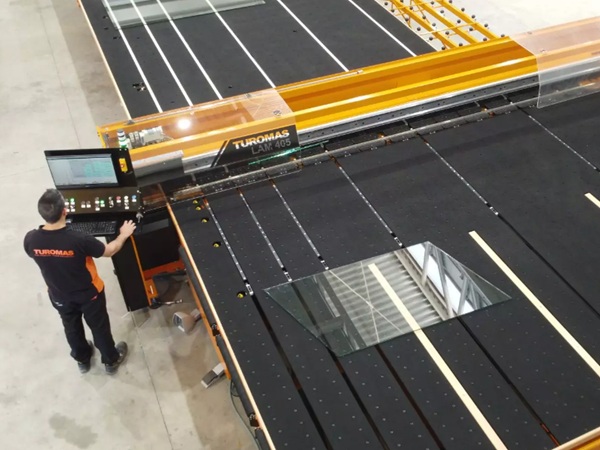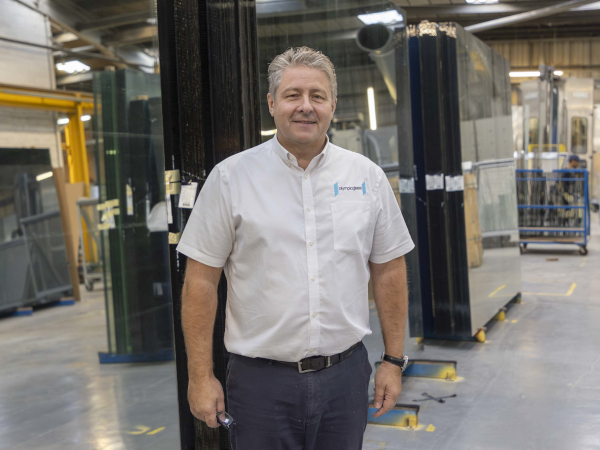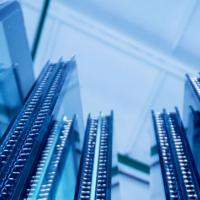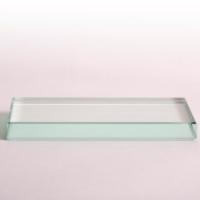Date: 29 May 2006
In the design and construction of modern automotive vehicles such as passenger cars, buses, coaches and goods transporters, the need to integrate large sheets of glass requiring intricate, often complex cut-out areas, has presented manufacturers with problems both technical and expensive in time and money.Now a breakthrough has been established by the leading Polish automotive glass supplier Saint-Gobain Sekurit HanGlas Polska, who have found that the installation of a high-accuracy Water Jet Sweden cutting machine at their Zary Plant has enabled them to cut-out any size or shape of area easily and economically. * Traditional method - traditionally, automotive safety glass is cut to size by first using automated profiling machines with diamond wheels to slit or score the surface for subsequent snapping off by skilled workers.
Straight-line work is easy, but contours and geometric shapes call for greater skills.
It has also long been possible to make holes in glass of reasonable diameters.
What has not been so practical, until now, has been the ability to produce internal cut-outs of any desired size or complexity.
The breakthrough has come about with the advent of water jet cutting equipment.
* Simple solutions - the Zary plant took delivery of the WJS NC3020S machine 18 months ago and technical director Marek Sulik with Wojciech Lipinski's project development team immediately set about making the process suitable for their particular needs.
Glass, by its very nature, shows up any defects that would probably not be evident no matter if present in other materials and so surface finish is of the utmost importance.
It was found, for example, that the conventional knife-edge 'wave formation' table normally recommended for use on the machine caused 'ricochet' marks on the underside of the glass and so a lot of thought and energy was put into finding an alternative means of support for the glass while being cut.
A highly-satisfactory solution was found that appeared delightfully simple in retrospect.
The table-top is positioned below the water level, but the glass sheets are supported well above it by a large number of freely positioned spacers in the form of rubber collars mounted on top of large-diameter plastic tubes.
This simple idea was immediately successful as it is now possible to quickly position the supports clear of the cutting path for any desired profile with the result that products are totally unmarked every time.
* Computer control - at a more detailed level, the development team naturally devoted much time to establishing the optimum combination of dynamic values for the various operating parameters of the abrasive water jet equipment.
These included: nozzle diameter, jet pressure (up to 4,000 bar) and rate of ramping it up, grit size (120 mesh garnet), traversing speed, including acceleration/ deceleration, and positioning.
In establishing most of these, the GE Fanuc 160i MB NC computer control system fitted was found to be extremely effective and, although it being the first controller from this supplier to be used at Zary.
Project engineer, Rutkowski, says it has been easy to program and, like the WJS machine itself, has been highly reliable.
The control panel is conveniently mounted on a swing-arm at one corner of the machine and is linked to the company's CAD/CAM facility, so that programs for any of the many parts to be produced can be called up instantly - important where jobs are for short runs and are ordered on a JIT basis from all over Europe.
* Fast, easy and environmentally friendly - in operation, the WJS machine was found to be clean, quiet and easy to use.
After the operator has lifted a sheet of glass from the vertical storage rack, located by the workstation, with the aid of its vacuum lift cradle, it is rotated to the horizontal plane and laid on the table against the positioning stops.
This takes just a few seconds and is all that is needed to be ready to cut.
The water jet cutting machine is then switched on and will run entirely automatically as it cuts the desired internal profile(s) in the glass.
Generally the tinted glass sheets involved are up to 2200 x 1900mm in size, well within the machine's 3.0 x 2.0m capacity, and the glass sheets may be as thick as required.
In a direct comparison with a situation where the production of windows with internal 'holes' was previously possible, the water jet cutting method enabled productivity to be increased by more than 300%, from 3 to 10/h.
Using the water jet system, both cut-outs and holes can be performed in a single setting without the need to transfer to a drilling machine.
* WJS accuracy attracts new business - as well as offering increased scope to designers for incorporating distinctive internal hole shapes within sheet glass, the system can also do things not possible by any other means.
For example, one designer wanted a pattern of 78 holes of 6mm diameter to be incorporated but such small holes (very close to each other) could not be drilled.
Thanks to the extremely small radii that the WJS machine can perform and its 0.1mm tolerance capability, the work could be taken on at Saint-Gobain Sekurit HanGlas Polska and, in fact, many jobs will now find their way to Zary because radii of less than 5mm are required.
Reasons for seeking internal cut-outs in vehicle glass, apart from the obvious ones of needing to position integral door handles, window latches etc, can be for enabling structural elements to pass through, for entire rear light clusters to be mounted in a back window, fuel pipe access and so on.
Saint-Gobain is confident that the capabilities of this Polish Water Jet Sweden installation will attract increasing business from all over Europe.

















Add new comment